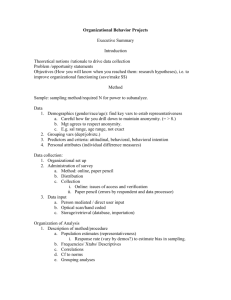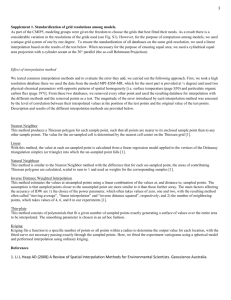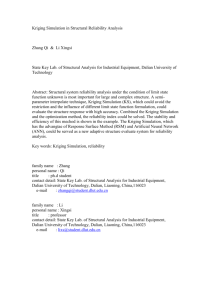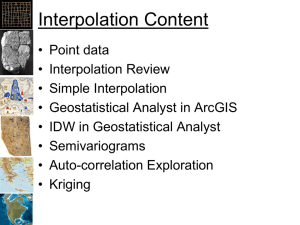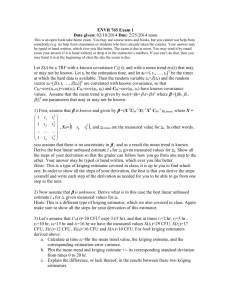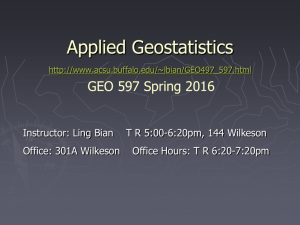SG1 - FAIRMODE
advertisement
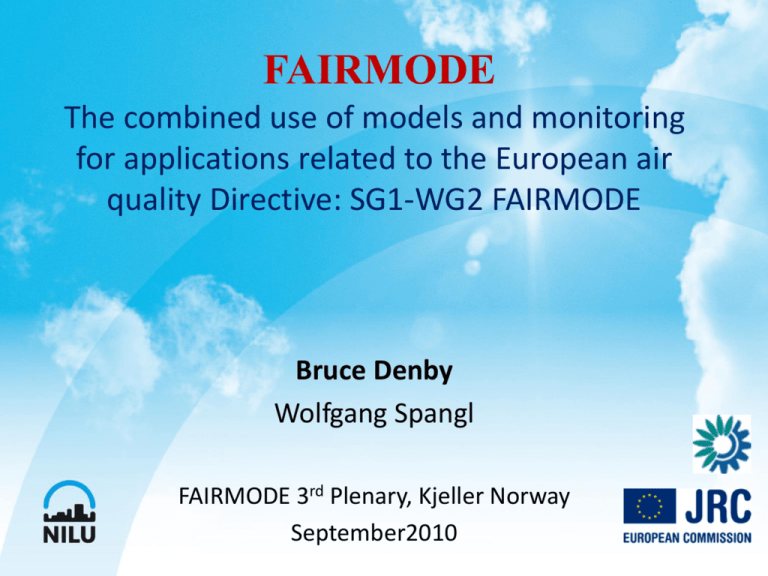
FAIRMODE The combined use of models and monitoring for applications related to the European air quality Directive: SG1-WG2 FAIRMODE Bruce Denby Wolfgang Spangl FAIRMODE 3rd Plenary, Kjeller Norway September2010 Content • • • • • Aims of SG1-WG2 Overview of methods Institute and activities list Registered FAIRMODE list Agenda and plans for today Aims of SG1 • To promote ‘good practice’ for combining models and monitoring (Directive related) • To provide a forum for modellers and users interested in applying these methodologies • To develop and apply quality assurance practices when combining models and monitoring • To provide guidance on station representativeness and station selection Some concepts • ’Combination’ used as a general term • Data integration – Refers to any ‘bringing together’ of relevant and useful information for AQ modelling in one system (e.g. emissions/ meteorology/ satellite/ landuse/ population/ etc.) • Data fusion – The combination of separate data sources to form a new and optimal dataset (e.g. models/monitoring/satellite/land use/etc.). Statistically optimal but does not necessarily preserve the physical characteristics • Data assimilation – The active, during model integration, assimilation of observational data (e.g. monitoring/satellite). Physical laws are obeyed Increasing statistical expertise Expertise required for methods Bayesian heirarchical approaches Kriging methods Monte Carlo Markov Chain Optimal interpoaltion 4D var Ensemble Kalman filter Data assimilation GIS based methods Regression IDW Data fusion Modelling Increasing model expertise Users and developers (DA) Person Institute/project Contact Model Method Hendrik Elbern he@eurad.Uni-Koeln.DE EURAD-IM 3-4D var Martijn Schaap RIU/MACC/PASA DOBLE TNO/MACC martijn.schaap@tno.nl LOTOS_EURO S Ensemble Kalman filter L. Menut INERIS/MACC menut@lmd.polytechniqu e.fr CHIMERE Hilde Fagerli Met.no/MACC hilde.fagerli@met.no EMEP Optimal interpolation , residual kriging and EnKF (in development) 3 – 4D var (in development) Valentin Foltescu Sébastien Massart Bruno Sportisse SMHI/MACC MATCH CERFACS/MACC Valentin.Foltescu@smhi.s e massart@cerfacs.fr INRIA,CEREA Bruno.Sportisse@inria.fr Jeremy David Silver Jørgen Brandt NERI jds@dmu.dk jbr@dmu.dk MOCAGE/PAL M Polyphemus DEHM 2 – 4D var (in development) 3 -4D var Application (resolution) European forecasts (45 – 1 km) European assessments and forecasting (25km) European and Urban scale forecasts and assessments (25 km) European scale forecasts and assessment (25km) European to Urban scale (25 - ? km) Global to European 3 -4D var, OI, EnKF European Optimal interpolation. Future EnKF Europe Users and developers (DF:1) Person Institute/project Contact Model Method John Stedman AEAT John.stedman@aeat.co.uk ADMS Bruce Denby NILU/ETC-ACC bde@nilu.no EMEP, LOTOSEUROS Jan Horálek CHMI/ETC horalek@chmi.cz EMEP Dennis Sarigiannis JRC Ispra Dimosthenis.SARIGIAN NIS@ec.europa.eu Marta Garcia Vivanco Palomino Marquez Inmaculada Fernando Martín CIEMAT m.garcia@ciemat.es inma.palomino@ciemat.e s fernando.martin@ciemat. es CTDM+ (model not important, platform more relevant) ICAROS NET MELPUFF CHIMERE Statistical interpolation, residual kriging Statistical interpolation, residual kriging Statistical interpolation, residual kriging Data fusion (unknown methodology) Anisotropic inverse distance weighting Regression and residual kriging. Application (resolution) UK wide assessment of air quality European wide assessments at 10 km European wide assessments at 10 km Urban scale Assessment Spain Users and developers (DF:2) Person Institute/project Contact Model Method Clemens Mensink Stijn Janssen VITO stijn.janssen@vito.be Clemens.mensink@vito.b e RIO and BelEUROS J.A. van Jaarsveld Florian Pfäfflin (Goetz Wiegand Volker Diegmann ) RIVM hans.van.jaarsveld@rivm. nl fpf@ivu-umwelt.de OPS Detrended kriging. Land use regression model used for downscaling CTM Kriging with external drift Optimal interpolation Arno Graff Umwelt Bundes Amt, UBA II Dipartimento di Ingegneria dell'Informazione Università degli Studi di Brescia arno.graff@uba.de REMCALGRID TCAM Gabriele Candiani, Marialuisa Volta IVU Umwelt GmbH lvolta@ing.unibs.it gabriele.candiani@ing.un ibs.it FLADIS/ IMMISnet/ EURAD Optimal interpolation Optimal interpolation, kriging Application (resolution) Belgium (3km) Nederland (5km) Ruhr, Germany (5km) Germany Northern Italy Representativeness Person Institute/project Contact Wolfgang Spangl Umweltbundesamt Wolfgang.spangl@umwel tbundesamt.at Sverre Solberg NILU/EMEP sso@nilu.no Model Method Representativeness of monitoring data EMEP Representativeness of monitoring data Application (resolution) Austria EMEP monitoring network Registered for SG1 N. 1. 2. 3. 4. 5. 6. 7. 8. 9. 10. 11. 12. 13. 14. 15. 16. 17. 18. 19. 20. 21. 22. 23. 24. 25. 26. 27. 28. Name BRUCE DENBY (leader) WOLFGANG SPANGL BERTRAND BESSAGNET HENDRIK ELBERN THILO ERBERTSEDER ALBERTO GONZÁLEZ MARKE HONGISTO FERNANDO MARTIN CAMILLO SILIBELLO MARTIJN SCHAAP KEITH VINCENT GABRIELE ZANINI HILDE FAGERLI AMELA JERICEVIC CLARA RIBEIRO HANS VAN JAARSVELD MIREIA UDINA SISTACH ONDREJ VLCEK SUZANNE CALABRETTA-JONGEN CAMILLO SILIBELLO MARIALUISA THILO ERBERTSEDER RAHELA ZABKAR DAVID CARRUTHERS JOSE M. BALDASANO MARIA GONCALVES-AGEITOS GUUS VELDERS GUUS STEFESS e-mail bde@nilu.no wolfgang.spangl@umweltbundesamt.at abriele.bessagnet@ineris.fr he@eurad.uni-koeln.de thilo.erbertseder@dlr.de agortiz@mma.es marke.hongisto@fmi.fi abriele.martin@ciemat.es c.silibello@aria-net.it martijn.schaap@tno.nl keith.vincent@aeat.co.uk abriele.zanini@enea.it h.fagerli@met.no jericevic@cirus.dhz.hr clararibeiro@ua.pt hans.vanjaarsveld@pbl.nl mudina@am.ub.es vlcek@chmi.cz suzanne.jongen@vito.be c.silibello@aria-net.it lvolta@ing.unibs.it thilo.erbertseder@dlr.de rahela.zabkar@fmf.uni-lj.si david.carruthers@cerc.co.uk jose.baldasano@bsc.es maria.goncalves@bsc.es guus.velders@pbl.nl guus.stefess@rivm.nl Agenda today in SG1-WG2 • Status • Short presentation on representativeness (Wolfgang Spangl) • Discussion around activities for this and next year: – Defining representativeness for validation and assimilation purposes – Overview of institutes applying assimilation methods – Review of existing methods implemented in Europe. (Template and contributions) • Quality assurance and validation methods when combining monitoring and modelling (Input to SG4) • Financing and securing contributions to the activities of SG1 • 2011 activities (workshop, special session AQ conference) • Any other business Aims of SG1-WG2 2010 • Update list of institutes carrying out DA and DF • Develop an accessible review of these methods (→ WG1 ‘Good practise and guidance’) – Contributions from listed institutes • Recommend methods for quality assurance (→ SG4 ‘Bench marking’ → WG1 ‘guidance’) – Discussion today • Develop an understanding of representativeness (→ SG4 ’Bench marking’ → WG1 ‘guidance’) – Discussion today For information and contributions contact Bruce Denby bde@nilu.no and register interest on the website http://fairmode.ew.eea.europa.eu/ Some concepts • Geometrical methods – Methods for interpolation or ‘combination’ that are based on geometrical arguments. E.g. Inverse distance weighting, bilinear interpolation, as an interpolation method. Simple combinations of data, some GIS based methods. • Non spatio-temporal statistical methods – Covers methods such as regression and bias corrections that do not take into account the spatial or temporal correlation of the data. • Spatio-temporal statistical methods – Covers a wide range of methods e.g. 2-4 D variational methods, kriging methods, optimal interpolation. Based on Bayesian concepts. Minimalisation of some specified error. Examples: Regional scale Comparison of Residual kriging and Ensemble Kalman Filter for assessment of regional PM10 in Europe Residual kriging EnKF Model (LOTOS-EUROS) Denby B., M. Schaap, A. Segers, P. Builtjes and J. Horálek (2008). Comparison of two data assimilation methods for assessing PM10 exceedances on the European scale. Atmos. Environ. 42, 7122-7134. Examples: Regional scale Comparison of Residual kriging and Ensemble Kalman Filter for assessment of regional PM10 in Europe Residual kriging EnKF Model (LOTOS-EUROS) Denby B., M. Schaap, A. Segers, P. Builtjes and J. Horálek (2008). Comparison of two data assimilation methods for assessing PM10 exceedances on the European scale. Atmos. Environ. 42, 7122-7134. Examples: Regional scale MACC ensemble forecast system EPS Graph http://www.gmes-atmosphere.eu/. Examples: Regional scale MACC ensemble forecast system Model Assimilation method Implementation CHIMERE Innovative kriging, Ensemble Kalman filter Not implemented in operational forecasts EMEP Intermittent 3d-var In development EURAD Intermittent 3d-var Implemented in forecast, using ground based observations and satellite derived NO2 LOTOSEUROS Ensemble Kalman filter Not implemented in operational forecasts MATCH Ensemble Kalman filter In development MOCAGE 3d-FGAT and incremental 4dVAR Not implemented in operational forecasts SILAM Intermittent 4d-var Not implemented in operational forecasts http://www.gmes-atmosphere.eu/. Examples: Local and urban • Few examples of data fusion/assimilation on the local and urban scale – Spatial representativeness of monitoring sites is very limited (10 – 1000 m) – Often the number of sites is limited (compared to their spatial representativeness) – Monitoring contains little information for initialising forecasts • Application for assessment is possible – E.g. regression, optimal interpolation Representativeness • Two types of representativeness: – spatial and temporal (physical) – similarity (categorisation) • Knowledge of this is important for: – validation of models – data fusion/assimilation Representativeness • For modelling applications the representativeness of monitoring data should be reflected in the uncertainty of that data – NB: Not just the measurement uncertainty • This is reflected in the AQ Directive (Annex I) “The fixed measurements that have to be selected for comparison with modelling results shall be representative of the scale covered by the model” • Representativeness will be pollutant and indicator dependent Representativeness and the AQD • For monitoring the AQ Directive states: – For industrial areas concentrations should be representative of a 250 x 250 m area – for traffic emissions the assessment should be representative for a 100 m street segment – Urban background concentrations should be representative of several square kilometres – For rural stations (ecosystem assessment) the area for which the calculated concentrations are valid is 1000 km2 (30 x 30 km) • These monitoring requirements also set limits on model resolution Defining spatial representativeness • The degree of spatial variability within a specified area – e.g. within a 10 x 10 km region surrounding a station the variability is 30% – Useful for validation and for data assimilation • The size of the area with a specified spatial variability – e.g. < 20% of spatial mean (EUROAIRNET) or < 10% of observed concentration range in Europe (Spangl, 2007) – Useful for determining the spatial representativeness of a site Observed spatial variability Coefficient of variation σc/c for annual indicators as a function of area (diameter) for all stations (Airbase) 0.5 Variability of mean NO 2 (2006) Variability of mean PM10 (2006) Variability of SOMO35 (2006) 0.5 0.5 0.5 0.45 0.45 0.45 0.4 0.4 0.4 0.3 At 5km resolution variability is 34% 0.2 0 20 40 60 80 100 120 140 0 diameter PM10 0.35 0.3 SOMO35 0.35 0.3 24% 0.25 160 180 200 0.2 Lag distance (km) σc/c Coefficient of variation NO2 0.35 0.25 0.2 Coefficient of variation Coefficient of variation 47% 0.25 0 20 40 60 80 100 120 140 160 180 200 0.2 0 20 40 Lag distance (km) 200 km A random sampling within a 5km grid in an average European city will give this variability 60 80 100 120 Lag distance (km) 140 160 180 200
